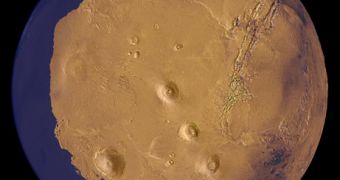Mars is a frigid desert and has a thin atmosphere and surface features reminiscent both of the impact craters of the Moon and the volcanoes, valleys, deserts and polar ice caps of Earth. This week, a team of scientists discovered the most compelling evidence of liquid water on Mars.
What happened to the lost oceans of Mars and Venus? So far, they don't exactly know, but they found evidence of an ancient ocean on the planet's northern plains. While mapping the surface of the planet, using images from the late-1970s Viking missions, they discovered a massive, sediment-filled basin surrounded by "shoreline-like" features.
These features, reminding of an ancient Martian ocean span for thousands of kilometers, around Arabia and Deuteronilus. The shorelines undulate like a long wave, rising and falling in height as much as several kilometers (more than a mile) along their length.
"That doesn't seem to jibe with the idea that they are shorelines, because shorelines form at sea level," said lead author Taylor Perron, a postdoctoral fellow in Harvard University's Department of Earth and Planetary Sciences.
Now, it seems that there really was an ocean in that area. The scientists think that Mars' poles, along with the axis the planet spins on, have moved about 1,850 miles (3,000 kilometers) during the past two or three billion years, a process known as "true polar wander," that causes dramatic terrain changes on the surface.
This is thought to have happened to the ocean on Mars, and made the once-flat shorelines rise and fall over enormous distances.
"When the spin axis moves relative to the surface, the surface deforms, and that is recorded in the shoreline," said co-author Michael Manga, professor of earth and planetary science at the University of California, Berkeley.
So far, this is the most conclusive evidence of an ancient liquid ocean on the Red Planet.

 14 DAY TRIAL //
14 DAY TRIAL //